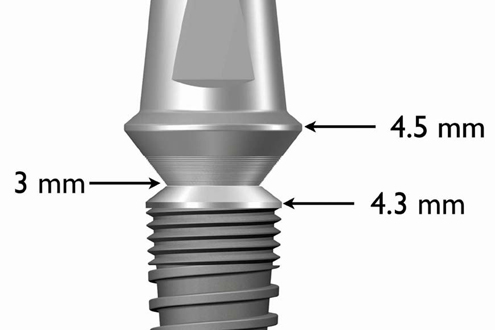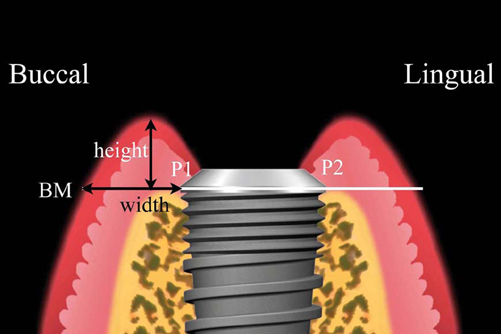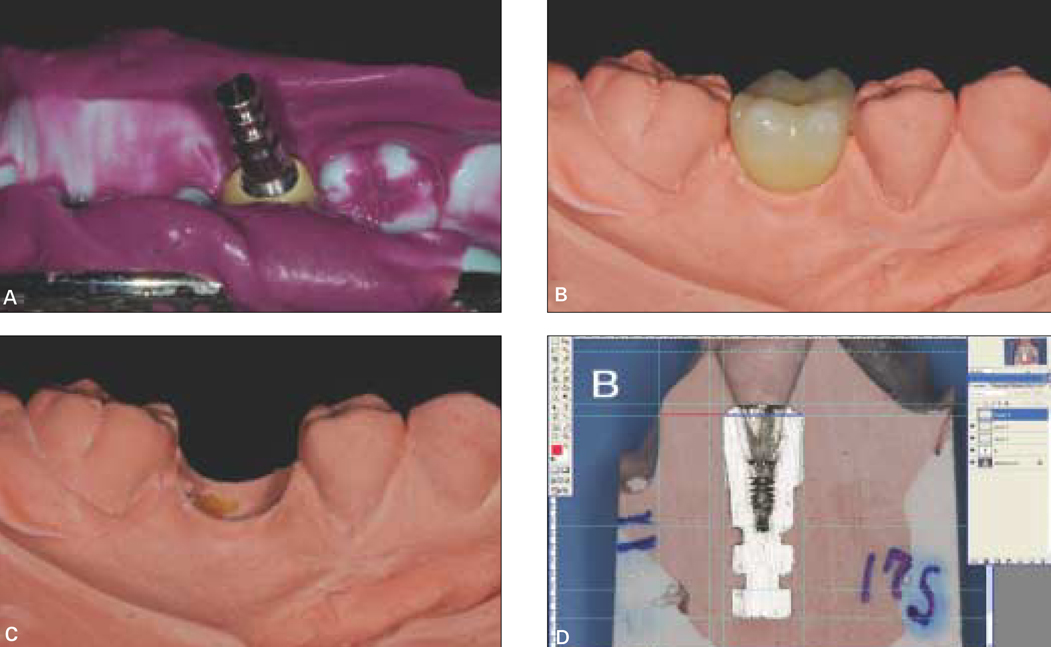J Adv Prosthodont.
2009 Nov;1(3):140-144.
The level of buccal gingival margin around single and two adjacent implant restorations: a preliminary result
- Affiliations
-
- 1Department of Prosthodontics, Gangnam Severance Dental Hospital, College of Dentistry, Yonsei University, Seoul, Korea. sunjai@yuhs.ac
Abstract
- STATEMENT OF PROBLEM: Little information is available about the buccal gingival level of multiple implant restorations. PURPOSE: This study was aimed to evaluate the relationship between width and height of buccal soft tissue around single and 2 adjacent implant restorations. MATERIAL AND METHODS: Four implant restoration groups (first and second molars, single second molars, posterior single restorations between teeth, and anterior single restorations between teeth) were randomly chosen from one dental institute. Each group comprised of 6 patients. After 6 months of function, silicone impressions were taken and stone models were fabricated for each restoration group. The stone models were cut in bucco-lingual direction at the most apical point of buccal gingival margin. The height and width of buccal supra-implant soft tissue were measured. One way ANOVA and Tukey HSD post hoc tests were performed to analyze the data obtained (P < .05). RESULTS: The most unfavorable width-height ratio was noted for the group, which was comprised of the second molar in the multiple adjacent (first and second molar) implant-supported restorations. The group also resulted in the shorter height of buccal supra-implant mucosa rather than that of anterior single implant restorations between natural teeth. CONCLUSION: To achieve a favorable level of buccal gingival margin, greater thickness of buccal supra-implant mucosa is required for the implant restorations without a neighboring natural tooth compared to the implant restorations next to a natural tooth.
Keyword
Figure
Reference
-
1. Buser D, Martin W, Belser UC. Optimizing esthetics for implant restorations in the anterior maxilla: anatomic and surgical considerations. Int J Oral Maxillofac Implants. 2004. 19:43–61.2. Jemt T. Restoring the gingival contour by means of provisional resin crowns after single-implant treatment. Int J Periodontics Restorative Dent. 1999. 19:20–29.3. Chang M, Wennström JL, Odman P, Andersson B. Implant supported single-tooth replacements compared to contralateral natural teeth. Crown and soft tissue dimensions. Clin Oral Implants Res. 1999. 10:185–194.4. Fürhauser R, Florescu D, Benesch T, Haas R, Mailath G, Watzek G. Evaluation of soft tissue around single-tooth implant crowns: the pink esthetic score. Clin Oral Implants Res. 2005. 16:639–644.5. Kois JC. Predictable single tooth peri-implant esthetics: five diagnostic keys. Compend Contin Educ Dent. 2001. 22:199–206. quiz 208.6. Evans CD, Chen ST. Esthetic outcomes of immediate implant placements. Clin Oral Implants Res. 2008. 19:73–80.7. Saadoun AP, Touati B. Soft tissue recession around implants: is it still unavoidable?-Part I. Pract Proced Aesthet Dent. 2007. 19:55–62. quiz 64.8. Grunder U. Stability of the mucosal topography around single-tooth implants and adjacent teeth: 1-year results. Int J Periodontics Restorative Dent. 2000. 20:11–17.9. Small PN, Tarnow DP. Gingival recession around implants: a 1-year longitudinal prospective study. Int J Oral Maxillofac Implants. 2000. 15:527–532.10. Bengazi F, Wennström JL, Lekholm U. Recession of the soft tissue margin at oral implants. A 2-year longitudinal prospective study. Clin Oral Implants Res. 1996. 7:303–310.11. Oates TW, West J, Jones J, Kaiser D, Cochran DL. Long-term changes in soft tissue height on the facial surface of dental implants. Implant Dent. 2002. 11:272–279.12. Nozawa T, Enomoto H, Tsurumaki S, Ito K. Biologic height-width ratio of the buccal supra-implant mucosa. Eur J Esthet Dent. 2006. 1:208–214.13. Choquet V, Hermans M, Adriaenssens P, Daelemans P, Tarnow DP, Malevez C. Clinical and radiographic evaluation of the papilla level adjacent to single-tooth dental implants. A retrospective study in the maxillary anterior region. J Periodontol. 2001. 72:1364–1371.14. Cornelini R, Cangini F, Covani U, Wilson TG Jr. Immediate restoration of implants placed into fresh extraction sockets for single-tooth replacement: a prospective clinical study. Int J Periodontics Restorative Dent. 2005. 25:439–447.15. Juodzbalys G, Wang HL. Soft and hard tissue assessment of immediate implant placement: a case series. Clin Oral Implants Res. 2007. 18:237–243.16. Tarnow D, Elian N, Fletcher P, Froum S, Magner A, Cho SC, Salama M, Salama H, Garber DA. Vertical distance from the crest of bone to the height of the interproximal papilla between adjacent implants. J Periodontol. 2003. 74:1785–1788.17. Tarnow DP, Cho SC, Wallace SS. The effect of inter-implant distance on the height of inter-implant bone crest. J Periodontol. 2000. 71:546–549.18. Wennström JL. Mucogingival considerations in orthodontic treatment. Semin Orthod. 1996. 2:46–54.19. Rompen E, Raepsaet N, Domken O, Touati B, Van Dooren E. Soft tissue stability at the facial aspect of gingivally converging abutments in the esthetic zone: a pilot clinical study. J Prosthet Dent. 2007. 97:S119–S125.
- Full Text Links
- Actions
-
Cited
- CITED
-
- Close
- Share
- Similar articles
-
- Effect of resin sealants on the reduction of microleakage in composite restorations
- The Effect of Three Surface Sealants on Microleakage of Class V Composite Resin Restorations
- Clinical performance of esthetic ceramic partial-coverage restorations with supra-gingival margin using minimally invasive tooth preparation method according to the concept of adhesive dentistry
- Digital intraoral impression for immediate provisional restoration of maxillary single implant: A case report
- Effect of biscover on the marginal microleakage of composite resin restoration




